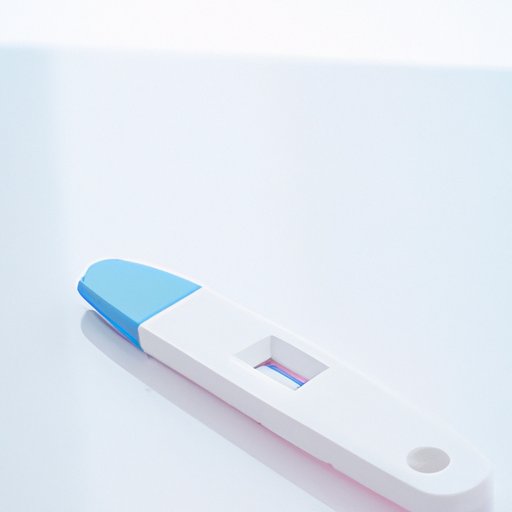Introduction
Taking a pregnancy test is an exciting and potentially nerve-wracking experience for anyone trying to conceive. It’s natural to have questions about when the best time to take a pregnancy test is, and it’s important to understand the potential outcomes of taking a pregnancy test too early or too late. In this article, we’ll explore the factors that influence when the optimal window for taking a pregnancy test is.
When Should You Take a Pregnancy Test?
There are several factors that can influence when you should take a pregnancy test. The most important factor is when your body has had enough time to produce hCG, or human chorionic gonadotropin, after conception. hCG is a hormone produced in the body during pregnancy. A pregnancy test looks for the presence of hCG in the body, so taking a test before your body has had enough time to produce hCG may result in an inaccurate reading.
Factors that Influence the Timing of a Pregnancy Test
The timing of a pregnancy test can also be influenced by other factors, such as when you had unprotected sex and when you expect your period. Since it can be difficult to pinpoint the exact date of conception, it’s best to wait until after you miss your period before taking a pregnancy test. This helps ensure that any results will be as accurate as possible.
Understanding Ovulation and Fertilization
Understanding ovulation and fertilization can also help you determine when the best time to take a pregnancy test is. Ovulation occurs when a mature egg is released from the ovary, usually around 14 days before the start of the next menstrual period. Fertilization occurs when the egg is joined with a sperm cell, and this typically happens within 12 to 24 hours after ovulation. If fertilization does occur, the fertilized egg will then travel to the uterus and implant itself in the uterine wall, where it will begin to produce hCG. This entire process takes about 6 to 12 days.
The Optimal Window for Taking a Pregnancy Test
The optimal window for taking a pregnancy test is usually 7 to 10 days after fertilization. This gives the body enough time to produce hCG, and ensures that any results will be as accurate as possible. However, some home pregnancy tests claim to be sensitive enough to detect hCG levels as early as 5 days before your expected period. It’s important to remember that these tests may not be as accurate as waiting until 7 to 10 days after fertilization.
How to Know When to Take a Pregnancy Test
In addition to understanding when the optimal window for taking a pregnancy test is, it’s also important to know how to recognize signs and symptoms of early pregnancy. These signs and symptoms can help you determine when you should take a pregnancy test. Common signs and symptoms of early pregnancy include nausea, fatigue, breast tenderness, frequent urination, and missed periods.
Signs and Symptoms of Early Pregnancy
Nausea is one of the most common signs of early pregnancy, and it can range from mild to severe. Fatigue is another common symptom, and many women find that they need more rest than usual. Breast tenderness is also common, and many women experience a tingling or soreness in their breasts. Frequent urination is another sign, as your body needs more fluids to support the growing fetus. Finally, a missed period is one of the most obvious signs of pregnancy.
Home Pregnancy Tests
Home pregnancy tests are widely available and easy to use. They work by detecting hCG levels in the urine. Most home pregnancy tests recommend taking them 7 to 10 days after fertilization, which is usually around the same time you would expect your period. It’s important to read the instructions carefully before taking the test, as some tests require you to hold the stick in your urine stream for a few seconds while others require you to collect your urine in a cup. Home pregnancy tests can be very accurate if used correctly.
Professional Pregnancy Tests
If you’re unsure when to take a pregnancy test, you may want to consider consulting with your doctor. Professional pregnancy tests are more accurate than home pregnancy tests, and they can detect even lower levels of hCG. Your doctor may also be able to provide advice on how to interpret the results of a pregnancy test.
Conclusion
Taking a pregnancy test is an important step for anyone trying to conceive. The timing of a pregnancy test can be influenced by several factors, such as when you had unprotected sex and when you expect your period. Understanding ovulation and fertilization can also help you determine when the best time to take a pregnancy test is. Signs and symptoms of early pregnancy can also help you decide when to take a pregnancy test. Home pregnancy tests are widely available and easy to use, and professional pregnancy tests are more accurate. Ultimately, the optimal window for taking a pregnancy test is usually 7 to 10 days after fertilization.
It’s important to remember that taking a pregnancy test too early may result in an inaccurate reading, so it’s best to wait until 7 to 10 days after fertilization to get the most accurate results. Finally, it’s always a good idea to consult with your doctor if you have any questions or concerns about when to take a pregnancy test.
(Note: Is this article not meeting your expectations? Do you have knowledge or insights to share? Unlock new opportunities and expand your reach by joining our authors team. Click Registration to join us and share your expertise with our readers.)
